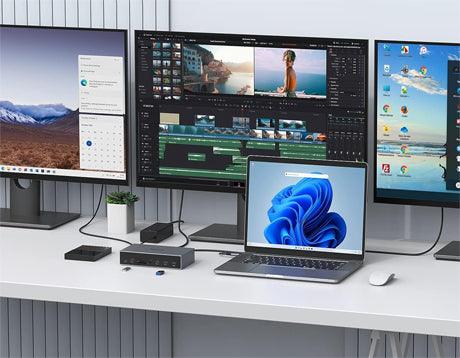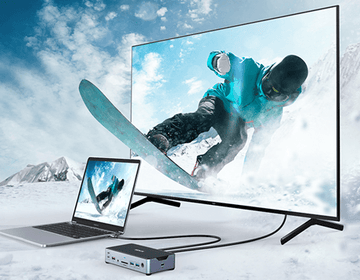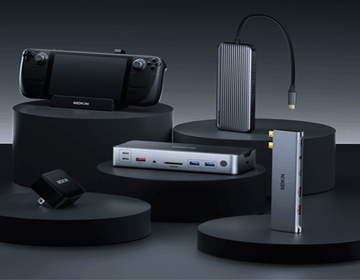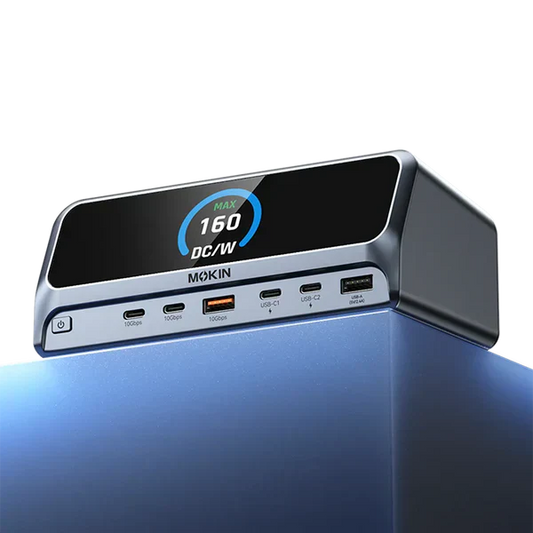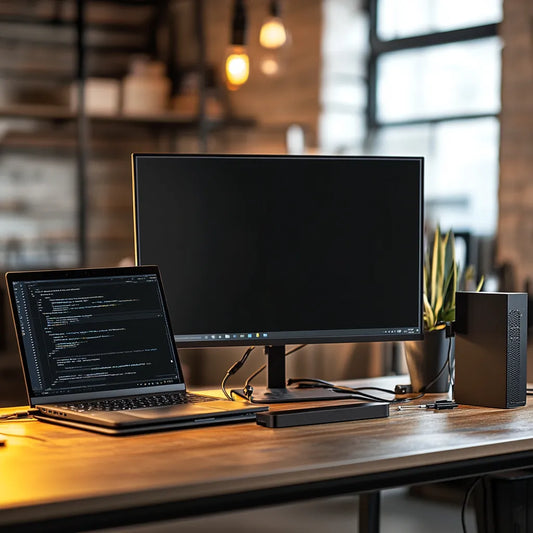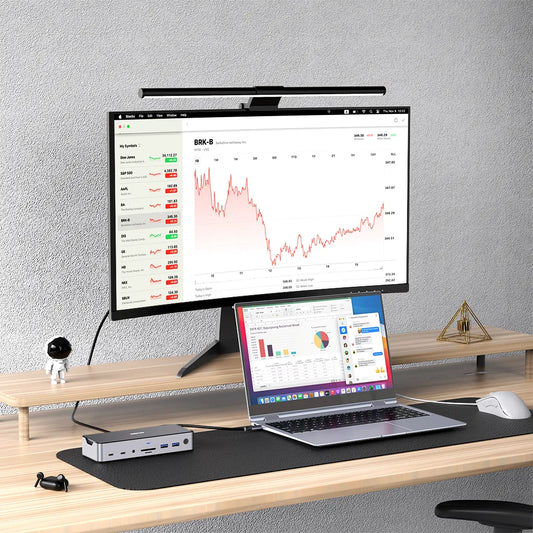Unlocking the Potential: Exploring Laptop Docking Stations
Contents
In today’s fast-moving world, the importance of productivity cannot be overstated. As an efficient tool, docking stations play an paramount role in optimizing your work process. Docking stations serve as a central connector for connecting more external devices and peripherals. They bring numerous advantages that take your workstation setup to the next level. The market for docking stations has experienced growth, reflecting the rising demand for laptop setups in home and office use. Explore all of the applications of docking stations for better connectivity and convenience.
Docking stations let you switch between workstations and access a wide range of ports. They provide ergonomic comfort by transforming laptops into desktop-like setups, improving posture during extended usage. The increased importance of mobile devices due to the rising number of applications such as communication, data collection, inventory management, vehicle tracking, and merchandising coupled with the rising popularity of bring-your-own-device to name a few. Additionally, rising demands for cutting work-related expenses and increasing flexibility measures will boost the growth of the global docking station market during the advent of the forecast period. Moreover, the rising need for rapid data transfer coupled with the development of technologies such as USB C, USB 3.0, and thunderbolt charging will further increase the footprint of the global docking station market during the advent of the forecast period. A docking station functions as a centralized connectivity solution, expanding the capabilities of laptops, tablets, and smartphones by providing additional ports, charging options. It also offer the ability to connect multiple peripherals simultaneously.
What is a Docking Station?
A docking station is an electronic connector made for converting your laptop or computer into a high-performance desktop workstation. By simply connecting your laptop to the docking station using a single cable, you can gain access to multiple ports and functionalities. It is particularly beneficial for individuals who frequently travel or those who require a versatile workspace. Docking stations have the ability to transform mobile devices into desktop workstations, providing simplified connectivity and adaptability. There are various types of docking stations available, such as expansion docks, port replicators, breakout docks, proprietary docks, and third-party docks.
How Do Docking Stations Work
A laptop docking station links a laptop to numerous peripheral devices, forming a versatile workstation and enhancing work efficiency. Compared to a regular hub, a laptop docking station has its own power supply to charge both the laptop and connected peripherals. With a variety of ports, it is able to extend one or more monitors. Supported video ports typically include HDMI, DisplayPort, mini-DisplayPort, VGA, and DVI. In addition, docking stations often come with card readers, Gigabit Ethernet, and different audio connections.
Learn how to connect and configure docking stations. Make sure the ports available on your laptop are compatible with the docking station. Plug the docking station into the power source using its own adapter. Then, connect the docking station to your laptop or computer using the appropriate cable. Attach your peripherals such as monitors, keyboards, mice, external storage devices, and other accessories to the available ports on the docking station. Switch on the docking station and configure settings. Install the specific driver. Adjust display settings, audio preferences, and network settings. When configuring the docking station, refer to the user manual or manufacturer's instructions. Once the docking station is connected and configured, test the functionality of the peripherals and ensure that they are working well.
Types of Docking Stations
Docking stations can be divided into two types: stationary docks and portable docks. Stationary docking stations typically rely on an AC or DC power adapter to power your PC or laptop. Traditional docking stations are stationary, which are usually used at fixed locations like homes and offices. A stationary dock having its own power source is usually the best choice if the dock will not go on the move with you. While the portable docking station can only draw power directly from your computer. Portable docking station itself is usually pretty small and doesn’t take up much space, which can be great if you don’t have much room on your desk. However, portable docks offer fewer ports than stationary docks.
The Purpose of Docking Stations
Desktop docking stations allow users to operate the device without holding it. They are particularly beneficial for individuals who primarily work in a fixed location. These docking stations typically feature a range of functionalities, including audio output, video output, network connectivity, and more. Office docking stations are designed to expand the number of available ports on a mobile device, allowing for the connection of additional devices or peripherals. They eliminate the need to repeatedly disconnect and reconnect individual cables when moving the device from a desk or returning to it. They help you save time and effort, reducing the risk of cords being tangled, or damaged. On the other hand, desktop docks are stationary, lacking portability or interactivity.
The portable docking station offers an ideal solution for professionals who are always on the go or frequently travel. With a compact docking station, you can easily connect more peripherals to your laptop or tablet, effectively transforming it into a versatile workstation.
Docking Stations with Dual Monitors
Docking stations with dual monitors support hook up to two displays. Connecting two screens to a laptop is pretty simple if you choose a dual-monitor docking station. The first thing to make sure is that your laptop is compatible with the docking station before setting up dual monitors. It’s important to match your laptop’s video-output capabilities to those of the dock. A dock that supports higher resolutions and refresh rates than your laptop’s USB C port will not extend those capabilities to the laptop. And ensure that the docking station supports the resolution and refresh rate of the external displays. Once the hardware selection has been completed, you have to set up two monitors, the laptop and the docking station in the correct manner. Plug the power cable of your docking station into the wall outlet and connect the docking station to your laptop. Connect two monitors to the docking station with video cables. Switch on the monitors and your laptop. And then right click on the desktop screen and select "Display Settings". If the laptop does not automatically detect the connected monitors, click on “Detect” to do so manually. Once you see your laptop screen on your monitor, click ”Identify” on the Display Settings.
Pay attention to the numbers that pop up on your laptop and monitors, and line up these devices according to the numbers shown. At last, select "Extend" or "Duplicate" from the drop-down menu as needed.
Advantages of Docking Stations
A docking station is a crucial device that offers increased connectivity choices, functioning as a centralized hub for all necessary tools. Docking stations have the potential to improve multitasking and overall work experience, making it more efficient and productive than ever before. Whether your aim is to streamline your team's workflow, reduce clutter, or foster better collaboration, docking stations can help you achieve the goals.
One of the key benefits of utilizing a docking station is that it provides a full desktop experience with just a single cable. By connecting a docking station to your laptop, you can gain easy access to various peripherals like projectors, keyboards, mice, printers, and more. Furthermore, a desktop docking station eliminates the requirement for multiple cables and power adapters, streamlining your setup and reducing clutter. Docking stations enable you to work more efficiently whether you're connecting in the office or from your home. Another significant advantage of using a docking station is that it provides more connections than your laptop. Most docking stations bundle a variety of useful ports, including USB, HDMI, DP, Ethernet, audio,etc. The expanded connectivity options allow for more effective work, as you have quick and convenient access to all your essential tools. For example, USB A ports provide compatibility with a wide range of peripherals, including keyboards, mice, external hard drives, and more. With the rise of USB C technology, modern docking stations incorporate USB C ports. These ports offer faster data transfer rates and support various devices, including smartphones and tablets. HDMI ports enable the connection of external monitors and projectors, which provides an enhanced visual experience for presentations, meetings, creative work, or multitasking. For situations requiring a stable and fast wired network connection, docking stations often include a Gigabit Ethernet port. It ensures seamless connectivity in environments with limited Wi-Fi coverage. A combo audio jack can be used to connect speakers or headphones. With more connections, you can enhance your desktop experience and work more efficiently. Docking stations enhance visual productivity by connecting more external monitors to your laptop. The multi-screen effect makes work more efficient. With additional monitors, you don’t need to constantly switch between different screens, creating a more immersive and productive workspace. What’s more, docking stations contribute to reducing cable clutter. Laptop docking stations for dual monitors can be utilized to manage your desk space. Employing a dock promotes a tidy and organized desk setup. With a desktop docking station, all essential peripherals can be connected to a single device, eliminating the necessary for multiple cables and power adapters. A tidier workspace can enhance your productivity by reducing distractions.
Conclusion
Docking stations can indeed bring out your laptop’s true potential. They play an important role in mobile work and office environments, greatly enhancing your work efficiency in several aspects. They offer a full desktop experience with just a single cable, giving you access to data, video, and power, etc. The extended extra ports is able to simplify your workspace and reduce clutter. Multi-functional docking stations increase visual productivity by connecting more additional monitors to your laptop or computer. Portable docks ensure that your laptop is always ready to go.
Overall, docking stations provide convenience, flexibility, and enhanced functionality for laptop users. They allow you to unlock your laptop's true potential by expanding its connectivity options, supporting multiple monitors, improving ergonomics, and simplifying the connection process. With all these benefits, docking stations are becoming more and more popular.

MOKiN 13-IN-1 USB-C Laptop Charging Station with 2.26-inch LCD Smart Display

